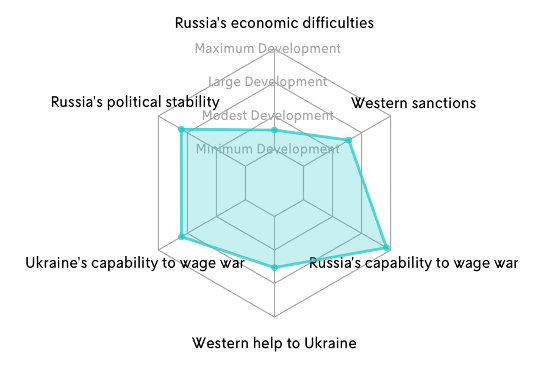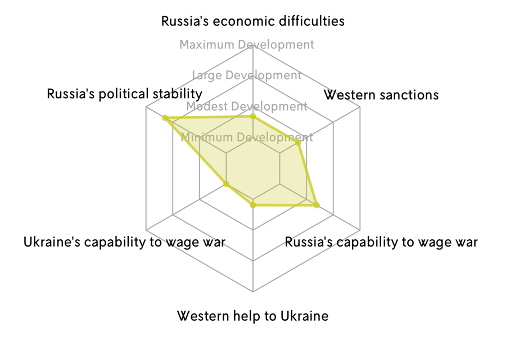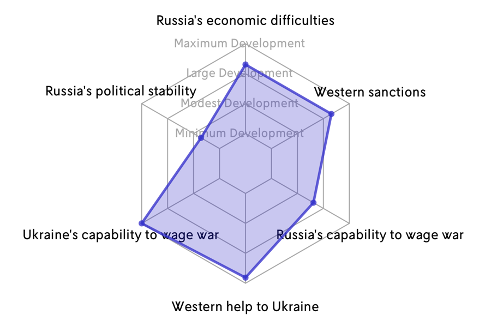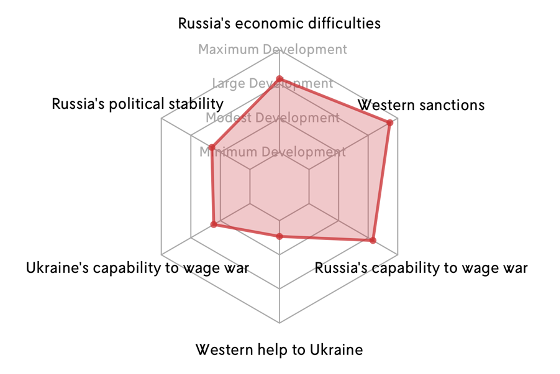Four scenarios on how the war in Ukraine may play out
The war in Ukraine has brought major disruption and new uncertainties to several sectors. To help organisations successfully navigate the constantly evolving environment ahead, Futures Platform’s team of futurists has outlined four different scenarios on how the war may evolve within the next five years.
Dr. Tuomo Kuosa
Co-founder and Director of Futures Research at Futures Platform. Kuosa holds a PhD from the Turku School of Economics and is an Associate Professor (Docent) of Strategic Foresight at the Finnish National Defence University.
Max Stucki
As Senior Manager at Futures Platform, Max is responsible for supervising and developing the foresight analysis process. He has worked with numerous clients to help them prepare for the future.
FUTURE PROOF – BLOG BY FUTURES PLATFORM
Russia’s war in Ukraine has triggered seismic shifts across the energy sector, food supply chains, financial markets, and global trade routes. Even if the war would end soon, its ramifications will likely be felt for many years to come. To help organisations prepare for a range of different future possibilities, our team of futurists has outlined four scenarios that describe how the war may evolve within the next five years ahead, along with the impacts each scenario would have on a global scale.
While they’re not an exhaustive list of all the possible future directions the war may take, the four scenarios below are designed to help decision-makers stress-test organisational strategies and see the current situation in a new light – uncovering the potential risks, outcomes and opportunities that may have otherwise gone unnoticed.
In our scenario-building process, we focused on the following set of key driving forces that will influence the eventual future direction and outcome of the war:
Russia's economic difficulties
Russia's political stability
Russia's capability to wage war
Ukraine's capability to wage war
Western help to Ukraine
Western sanctions against Russia
In each scenario, we examine the different ways these drivers may evolve in the years ahead, as well as the different ways they may interact and influence each other. All four scenario descriptions also include a development timeline section, which lists three to four steps that could plausibly happen to move us closer to the given scenario. The purpose of this section is to give readers a list of signs and indicators to look out for when monitoring future developments.
SCENARIO 1
The Ukraine war becomes a frozen conflict
Although Russia improves its military performance, the Ukrainian forces eventually manage to fight the invaders to a standstill, thanks mainly to massive Western help. The frontlines become static, and the Ukraine war becomes a frozen conflict with neither side willing to negotiate for peace. Moscow feels that as Russia is now cut off from the West anyway, it can settle issues with other neighbouring non-NATO countries. Russia conducts a swift, limited strike on Kazakhstan to install a puppet regime, and then masses troops to Georgia’s border to intimidate Tbilisi toward friendlier policies with Moscow. The West is unwilling to help Kazakhstan as it is far away from its main areas of interest. Georgia receives some support, but the Western governments recognise that should Moscow decide to attack, there would be little to do. Although the sanctions are still in place, Russia’s economy is able to sustain the nation thanks to help from China and India, who increasingly buy Russian energy and supply the country with the most critical components.
Development path for scenario 1
2023: The frontlines in Ukraine become static. Russia is no longer willing to commit large numbers of troops for a potential yet costly breakthrough. Ukrainian troops are unable to gather enough strength for a strategic counterattack.
2024: As the war is now mostly defensive in nature, Russia is able to release units from Ukraine and redeploy them to the Kazakhstan border. Moscow launches a swift attack that decapitates the current Kazakh leadership and replaces it with an extremely pro-Russian one. Russia solidifies Kazakhstan’s position as the buffer protecting Russia’s “underbelly”.
2025: Russia starts to gather forces on the Georgian border. The country hasn’t been able to get into the EU or NATO and remains vulnerable. No Western government is willing to guarantee Georgia, and Russia seems to aim to change the government with a friendlier one.
SCENARIO 2
Russia wins in Ukraine and continues expansion while China attacks Taiwan
Russia is able to break through in Ukraine and occupy the main cities. The Ukrainian government is replaced with a pro-Russian one led by the reappointed President Yanukovych, and Russia establishes military bases around Ukraine. Although guerrilla warfare continues in Ukraine, Russia is able to relocate its troops to its Baltic and Eastern European borders. NATO hasn’t been able to show enough support for the three Baltic republics due to the indecisiveness of the US after the re-election of Donald Trump, and Russia occupies Estonia, Latvia and Lithuania through a quick and aggressive campaign. NATO as a whole starts to mobilise for a full-scale war with Russia. While the West is focused on Europe, China begins its massive invasion of Taiwan just days after. The Third World War seems to have become a reality, and no one knows what new alliances will emerge, what chain reactions it will trigger, and most disturbingly, whether it will be fought using nuclear weapons.
Development path for scenario 2
2023: Western resolve to support Ukraine keeps weakening, as the public in many countries is more concerned with inflation and declining economy. Ukraine falls after a successful Russian summer campaign. Guerrilla war continues, but Russia is able to muster pro-Russian troops from Ukraine to handle most of the occupation duties.
2025: Trump’s re-election leads to severe friction with other NATO members. Trump halts the alliance’s plans to support the Baltics, even though individual countries, such as the UK, are still willing to commit to defending the republics.
2025: Russia moves into a full-scale war economy, seizing the nation´s heavy industries. Kremlin puts all its efforts into building weapons and renewing its army based on the heavy lessons of the Ukraine war.
2026: Russia successfully mobilises its reservist army and puts martial law in effect.
2027: Russia, together with Belarus, invades the Baltic countries that haven’t yet received the planned NATO reinforcements. The three republics fall to the massive Russian onslaught. At the same time, China launches its invasion of Taiwan. The US and its allies are now at war with both Russia and China.
SCENARIO 3
The costs of the Ukraine war cause Russia to collapse internally
With massive Western military aid, Ukraine is able to stop Russian forces from advancing and takes occupied territories back. At the same time, Russia’s economy can no longer sustain civilian consumption, leading to shortages and rapidly increasing prices. Russian elite is fractured and starts an internal fight for supremacy, leading to clashes between various security authorities within the country. Even Russian military units loyal to different factions take part in the fight. Maintaining effective control of the nuclear weapon arsenal becomes impossible, diminishing the Russian nuclear weapons deterrence. As the internal chaos seems to get out of hand in Russia, Turkey is seeking to establish its position as the leading power in both Syria and the Caucasus. Other countries, e.g. China, are also observing whether they can gain territory as Moscow can no longer protect its borders. Millions of Russians try to leave the country for safety. The oil and gas exports collapse, and Russia’s future within its current borders looks uncertain.
Development path for scenario 3
2023: Ukraine receives a continuous supply of weapons from the West, while Russia is increasingly unable to cover the losses it suffers. Russian consumers have become very familiar with shortages of many essential goods, while products imported from abroad have become more and more expensive.
2024: Ukraine has managed to launch several counteroffensives and successfully drive the Russian troops back on many fronts. The deteriorating military and economic situation is making Kremlin increasingly nervous.
2025: The worsening military and economic situation has led to an intra-elite conflict in Russia. Different cliques are trying to gain power, and the country is thrown into chaos. Turkey, China, and others are actively seeking to benefit from the situation.
SCENARIO 4
Russia wins in Ukraine, but the West keeps it isolated and contained
Russia gradually takes over more parts of Ukraine through a long, costly, and difficult campaign. The Western powers keep supplying Ukrainian resistance forces, and the sanctions against Russia are intensified. Russia’s economy, especially the manufacturing sector, has suffered, but Russia has eventually been able to overcome some of the worst supply chain disruptions. Russia’s internal stability is maintained through the use of force, but the general public is mainly unsatisfied because of decreasing living standards and lack of freedom. Although weakened, Russia has maintained its capability to fight on a satisfactory level and is free to redeploy its forces elsewhere, potentially being able to threaten the Baltics, Finland or some other nations. However, this remains unlikely.
Development path for scenario 4
2024: The war in Ukraine has gone on for two years. Russia has forced its way to Kyiv. However, Ukraine is unwilling to yield and fights on, thanks to Western help. The Russian economy has managed to source the most critical components from elsewhere than the West.
2025: Most of Ukraine is now under Russia’s control. Some pockets in westernmost Ukraine still hold on. NATO has built up its readiness forces near Russia’s borders.
2026: Ukraine is fully under Russia’s control. Millions of Ukrainians have left the country. Guerrilla war is waged, particularly in Western Ukraine. Russia is almost fully cut off from any Western economic activity, and its economy will likely suffer for many years to come. Russia isn’t able to recover its ruined military strength. Despite internal discontent, the Russian government is likely to remain unchallenged because of its monopoly on propaganda and violence.
2027: Russia renominates President Yanukovych to lead Ukraine as its puppet ruler. Ukraine stays in turmoil for many years.









